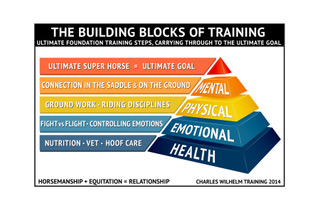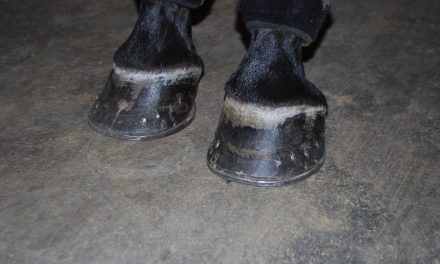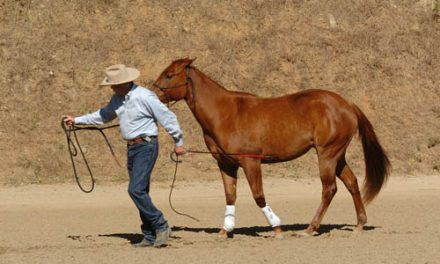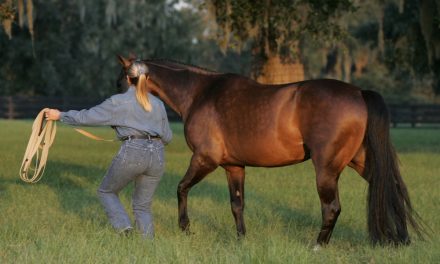
It is relatively common for a young horse to dislike having his feet or
legs worked on. Horses are prey animals. It takes a lot of trust for a
horse to allow a foot to be picked up as this prevents the horse from
running away. Your horse may be used to you and be relaxed when you
pick up a foot to clean it but you do represent the pressure around the
feet and legs that a farrier will. It is common, particularly for a young
horse, to dislike being shod but if the horse hasn’t learned to accept
pressure of any kind, he is going to react with fight or flight. Also,
farriers with their chaps, tool boxes and other equipment may be
frightening for a young horse.
Situations like a horse fighting a farrier are why I do a lot of basic
foundation training. All horses need this type of training. Horses must
learn to pick up their feet on cue. They also must learn to accept pressure
around the feet. In training, we put more pressure on a horse around the
feet and legs than an owner. An owner will usually be gentle, maybe too
gentle. We want to push buttons. We want the horse to react and then we
work with the horse to get it used to the pressure. We do this to prevent
someone coming along and touching the horse or trying to pick up a foot
and getting kicked.
As we progress in the training of a horse, we add more pressure around
the legs and feet. We pick up the feet, bump the legs, and we use a
dressage stick to tap on the legs and body. The horse may be aggravated
but will eventually get used to it and accept it. Imagine a small child
running up to a horse and grabbing a leg. I have seen this happen. A
horse that is accustomed to pressure around the legs will likely do
nothing. An untrained horse may rear, kick, or jump and injure the child.
I think of a horse in terms of a pyramid. The base has four corners. Each
corner represents an aspect of the horse: mental, physical, emotional and
nutritional. A horse needs to be mentally engaged, to learn to respond to
physical cues, to be calm and to have proper nutrition. All additional
learning comes from this base. Working with the emotions of a horse is
one of the more difficult areas and one that takes knowledge of how to
do it and patience in doing it.
A farrier may put a stud chain on a horse to gain control. If this is the
first time in the horse’s experience, the horse will go into fight and flight
mode. Things can get ugly very quickly. Flight instinct causes horses to
go through fences, over cliffs, run out in front of cars and run over their
owners. Horses don’t have the concept of preservation except to flee or
fight. This is why we must gradually build up a tolerance of pressure.
We begin by tapping, not hitting, with a dressage stick. Once the horse is
comfortable with that we pick up the legs. We sack out the horse with a
plastic bag and later a tarp. We put a soft cotton rope around the legs so
that if they ever get tangled up in something they won’t panic and hurt
themselves. By the time a horse is ready to see a farrier the horse is
totally calm being handled and touched around the feet and legs.
At my barn in Castro Valley we saw 35 to 40 horses a month and they all
went through this type of training. I once had a horse come in that
supposedly had to be drugged because he would not let a farrier get near
him. I worked with the horse for a couple of twenty minute periods
within an hour and then the farrier was able to put shoes on him without
him exploding and being concerned. When I started, the horse’s
emotional level was very high and he was ready to go into flight mode. I
worked through that and once he was quiet I began to work around his
legs to accept pressure. When the farrier came up to him it was no big
deal.
Most of the problems with a horse, no matter what they are, are caused
by a lack of basic foundation training. The solution is to start teaching
the horse in baby steps. You may be so excited to ride the horse that you
don’t want to take the time or you forget the importance of the basic
ground work. Every horse needs good ground manners. They also need
to accept the pressure of being around strangers, farriers, and vets. Your
horse needs to accept having his legs and feet touched. You should be
able to touch your horse all over. This may take time and you should
begin slowly with small steps, building up as the horse becomes more
accepting. You may need to find a trainer to work with the horse to build
up tolerance in steps.




